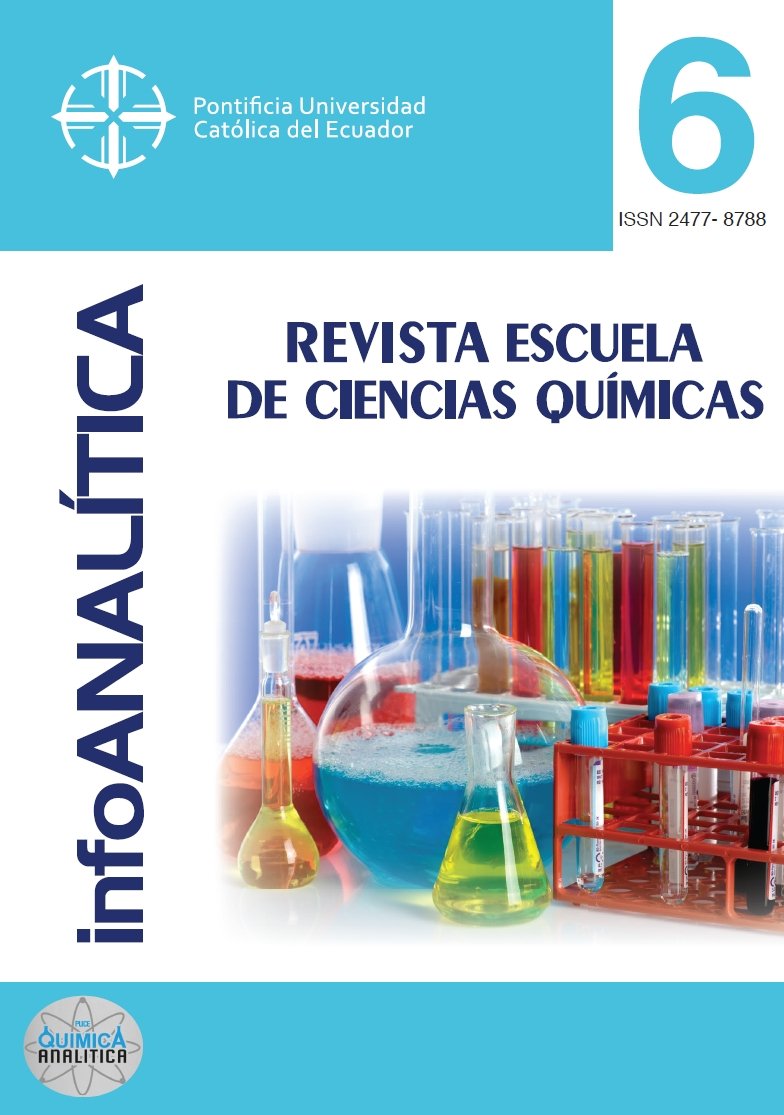Influence of stabilization by intermolecular copigmentation on the antioxidant capacity of antocianines of the fruit of Vaccinium Floribundum Kunth.
Main Article Content
Abstract
Anthocyanins from mortiño ( Vaccinium floribundum Kunth) were extracted by percolation, and stabilized by intermolecular copigmentation with rosmarinic acid, ferulic acid and a mixture 1:1 of these phenolic acids at concentrations of 120 and 960 mg/L. The antioxidant capacity of the non-copigmented antho- cyanin extract, copigmented extracts, pure copigments, ascorbic acid and cyani- din-3-glycoside was determined by the DPPH method. Curves Δ Absorbance vs Concentration were obtained by linear regression with experimental data. The slopes of the curves were used as comparison parameter. A relation was estab- lished between the slope of the ascorbic acid standard and slopes of the an- tioxidant compounds studied. The percentage ratio between the slope of the standard and the slope of antioxidants analyzed was calculated as increase or decrease antioxidant capacity. The chemical expression of the results was ob- tained by an inverse relation between the slope of the standard and samples. These results were named as: Antioxidant Capacity Equivalent to Ascorbic Acid, CAEA (acronym in Spanish). The results indicated that the antioxidant capacity of non-copigmented extracts is lower than from stabilized extracts. Copig- mented extracts with rosmarinic acid have a higher antioxidant capacity than copigmented extracts with ferulic acid. The anthocyanic extracts stabilized with mixture 1:1 have different behavior. The antioxidant capacity increases are caused by synergistic effect of the copigments.
Downloads
Article Details
- The authors agree to respect the academic information of other authors, and to assign the copyrights to the journal infoANALÍTICA, so that the article can be edited, published and distributed.
- The content of the scientific articles and the publications that appear in the journal is the exclusive responsibility of their authors. The distribution of the articles published in the infoANALÍTICA Journal is done under a Creative Commons Reconocimiento-CompartirIgual 4.0 Internacional License.
References
Arcilla-Lozano, C., Loarca-Piña, G., Lecona-Uribe, S., & Mejía, G. d. (2004). El orégano: propiedades, composición y actividad bilógica de sus componentes. Archivos latinoamericanos de nutrición, 54(1), 100-111.
Avello, M., & Suwalsky, M. (2006). Radicales libres, antioxidantes naturales y mecanismos de protección. Atenea(494), 161-172.
Brand-Williams, W., Cuvelier, M., & Berset, C. (1995). Use of a free radical method to evaluate antioxidant activity. LWT-Food Science and Technology, 28(1), 25-30.
Dalgo, M., José, M., Cuvi, A., & Guerrero, C. (2011). Relación del desarrollo del color con el contenido de antocianinas y clorofila en diferentes grados de madurez de mortiño (Vaccinium floribundum).
Dane. (2008). Estimación e interpretación del coeficiente de variación de la encuesta consensal, censo general 2005-CGRAL. Dane.
Eiro-Maarit, J., & Heinonen, M. (2002). Anthocyanin color behavior and stability durig storage: Efecct of intermolecular copigmentation. Journal of Agricultural and Food Chemistry, 7461-7466.
Ferrante, D., Linetzky, B., Konfino, A., King, A., Virgolini, M., & Laspiur, S. (2011). Encuesta nacional de factores de riesgo 2009: Evolución de la epidemia de enfermedades crónicas no transmsibles en Argentina. Estudio de corte.
Garzón, G. (2008). Las antocianinas como colorantes naturales y compuestos bioactivos. Acta biológica colombiana, 13(3), 27-36.
Gaviria, C., Ochoa, C., Sánchez, N., Medina, C., Lobo, M., Galeano, P., & ...Rojano, B. (2009). Actividad antioxidante e inhibición de la peroxidación lipídica de extractos de frutos de mortiño (Vaccinium meridionale SW). Boletín Latinoamericano y del Caribe de plantas medicinales y aromáticas, 8(6), 519-528.
Gordillo, B., Rodríguez, F., Escudero, M., Gonz{alez, M., & Heredia, F. (2012). Comprehensive colorimetric study of anthocyianic copigmentation in model solutions. Efects of pH and molar ratio. Journal of Agricultural and Food Chemistry, 60(11), 2896-2905.
He, J., & Giusti, M. (2010). Anthocyanins: Natural colorants with health promoting properties. Anual Review of Food Science and Technology, 1(1), 163-187.
Kim, D., Lee, H., & Lee, C. (2002). Vitamin C equivalent antioxidant capacity (VCEAC) of phenolic phytochemicals. Journal of Agricultural and Food Chemistry, 50(13), 3713-3717.
Kuskosky, E., Asuero, A., García-Parrilla, M., Troncoso, A., & Fett, R. (2004). Actividad antioxidante de pigmentos antociánicos. Ciencia e Tecnología de Alimentos, 24(4), 691-693.
Rein, M. (2005). Copigmentation reactions and color stability of berry anthociyanins. Helsinky: Universidad Helsinki.
Skoog, D., West, D., Holler, J., & Crounch, S. (2015). Fundamentos de Qu{imica Anal{itica. México: Cengage Learning.
Suárez, M., & Narváez, G. (2016). Copigmentación intermolecular de antocianinas glicosiladas. Madrid: Editorial Académica Española.
Zhao, C., Chen, Z., Bai, X., Ding, C., Long, T., Wei, F., & Miao, K. (2014). Structure-activity relationships of anthocyanidin glycosylation. Molecular Diversity, 18(3), 687-700.

